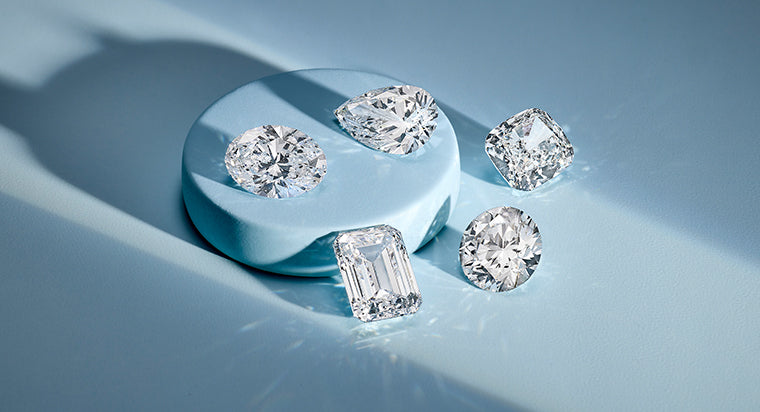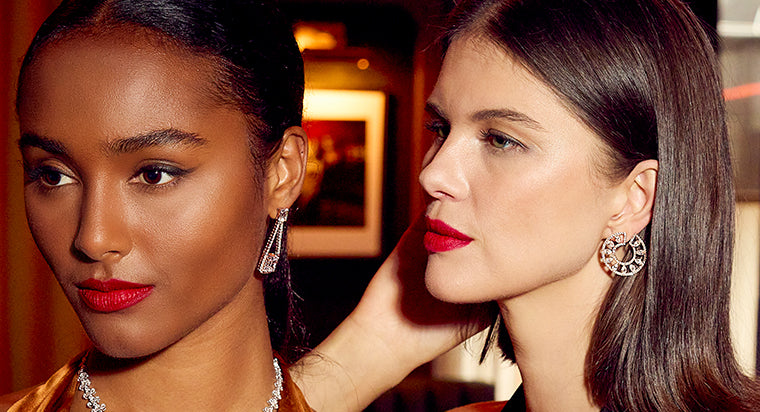Gold Engagement Rings vs. Platinum Engagement Rings

From the engagement ring design to the center stone, you have plenty of decisions to make. One crucial decision is the type of metal you'll use. Two popular choices are gold and platinum, and each type of metal has its own strength. Let's compare gold and platinum to help you determine which metal to choose for your diamond engagement ring.
TABLE OF CONTENTS
Durability and Strength
Both gold and platinum are strong, durable choices. Platinum is a denser metal, which makes it more durable than gold overall. It's a popular choice for engagement rings because of its durability.
Gold comes in 18k or 14k, which is the amount of pure gold in the metal mixture. A 14k gold option is stronger than 18k, but both are strong and durable. Gold tends to scratch more easily than platinum because it's less dense.
Color and Appearance
Gold comes in different shades, so you can choose the metal that best suits you. You'll find yellow, white, and rose that complement various styles. Some prefer one color metal over another, and having several gold options allows you to get a perfect gold engagement ring that feels like it was designed for you.
Platinum engagement ring has a natural white sheen that doesn't require plating like white gold. Its silvery-white appearance makes it ideal for your ring's timeless, bright look. Its silvery white hue beautifully complements both diamonds and colored gemstones, enhancing their brilliance and creating a sophisticated, modern aesthetic. Platinum's enduring brightness makes it an ideal choice for engagement rings.
Price and Affordability
Platinum is typically more expensive than gold because it is rarer and denser, so more metal is needed to create an engagement ring of the same size. Its density also gives platinum a naturally heavier feel, making it a premium choice for rings. On the other hand, gold, particularly in lower karats like 14k, offers a more budget-friendly option. The use of alloys in lower-karat gold not only makes it more affordable but also enhances its durability, providing a balance of cost and practicality if you'd like a beautiful yet economical metal choice.
Maintenance and Care
Platinum rings naturally develop a patina over time, which gives the metal a soft, matte appearance that many like because of its vintage, well-loved look. This patina doesn't indicate wear but rather a unique characteristic of platinum that adds to its charm. If you prefer the original shine, platinum can be easily polished by a jeweler to restore its lustrous finish.
As for your white gold engagement ring, it's rhodium-plated when it's brand new. Rhodium plating is a process in which a thin layer of rhodium, a rare and durable metal, is applied to jewelry to enhance its appearance and durability. The plating gives the diamond jewelry a bright, shiny finish and helps protect it from tarnishing and scratches. Rhodium is highly resistant to corrosion, which makes it ideal for maintaining the luster and longevity of your engagement ring. The plating wears off after years of wear, so you might need to get it replated to get it looking bright white once again.
Hypoallergenic Properties
Platinum is a naturally hypoallergenic metal, so it's an ideal engagement ring choice for individuals with metal sensitivities or allergies. Because it is nearly pure in jewelry form and contains minimal alloys, it is less likely to cause skin irritation. This makes platinum ideal for everyday wear, especially in engagement rings, because they're worn in close contact with the skin.
Gold, particularly in lower karats like 14, is often mixed with other metals, such as nickel, to increase its strength. Pure gold is very soft and malleable. Some alloy metals, like nickel, can cause allergic reactions in people with sensitive skin, leading to discomfort or irritation.
Weight and Comfort
Platinum's density makes it significantly heavier than gold that gives engagement rings a more substantial feel that some appreciate. The added weight of platinum can evoke a sense of durability and value, offering a tangible reminder of the quality of the piece. Some like the sensation of a solid, weighty engagement ring on their finger. However, others may prefer the lighter feel of gold, especially if comfort and ease of wear are priorities for daily use. Gold, especially in lower karats like 14k, is lighter and can be more comfortable for those who want a piece that feels less obtrusive. The choice between the weight of platinum and the lighter nature of gold ultimately comes down to personal preference, with each metal offering distinct advantages depending on your taste and lifestyle.
Symbolism and Tradition
Gold has been used in engagement rings for centuries, so it's deeply embedded in historical and cultural traditions. From ancient civilizations to royal engagements, gold has long symbolized wealth, love, and commitment. It's warm, timeless glow has made it a popular choice for significant occasions, and its versatility—whether in yellow, white, or rose gold—offers a range of options to suit various personal styles.
Platinum has come to represent modern luxury and exclusivity. Its rarity, coupled with its exceptional strength, makes it a symbol of durability and longevity—qualities that are highly desirable for engagement rings. Platinum's natural white sheen gives it a sleek, elegant appearance.
Customization and Style
Because gold is more malleable, you have more design and customization flexibility for your engagement ring. Platinum's strength works well for intricate designs, but it can be harder to mold it into complex shapes–at least compared to gold.
The decision between platinum and gold is a personal one that comes down to your taste, preferences, and budget. You have thousands of platinum and gold engagement ring options at With Clarity. Browse different styles at With Clarity and see which look you prefer. Remember that With Clarity is a great resource that can help you through the engagement ring process. They can answer any questions that you have and take pride in being honest and transparent during the engagement ring shopping process.









